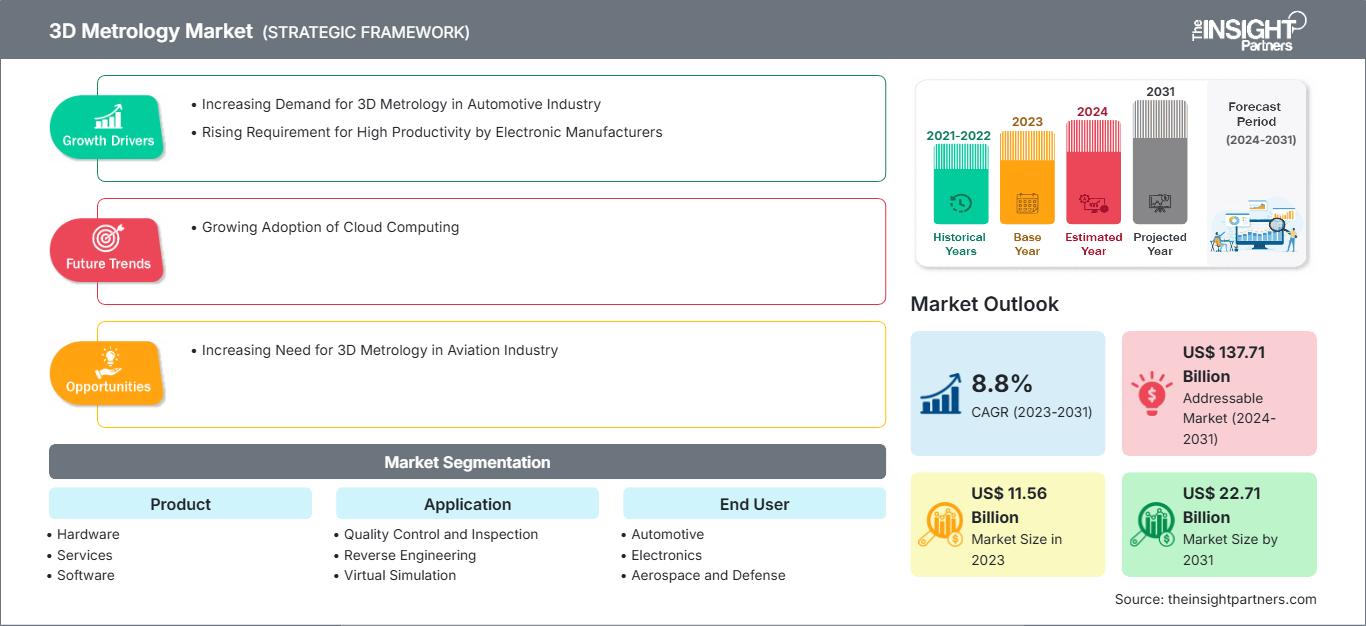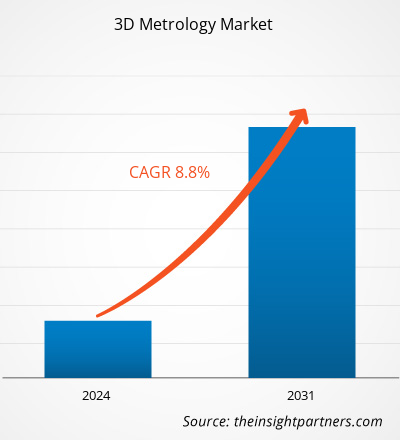3D 计量市场规模预计将从 2023 年的 115.6 亿美元增至 2031 年的 227.1 亿美元。预计该市场在 2023 年至 2031 年的复合年增长率为 8.8%。云计算的日益普及可能仍将是 3D 计量市场的主要趋势之一。
3D 计量市场分析
3D 计量市场预测是基于各种二手和一手研究结果估算的,例如主要公司出版物、协会数据和数据库。3D 计量是一门物理测量的科学研究,它采用能够生成物体几何形状完整 3D 表示的技术。3D 计量使用多种技术,包括非接触式结构化蓝光 3D 扫描仪、触觉坐标测量机 (CMM) 和计算机断层扫描 (CT)。这款 3D 计量设备可从物理组件收集实际数据,然后将其用于 3D 计量软件,以进行质量控制、精度评估和各种零件分析。
3D 计量市场概览
3D 计量是一种用于质量控制和其他制造或生产目的的技术。在最流行、最高效的 3D 计量类型中,立体相机用于精确扫描和测量零件,并使用结构化蓝光滤除不必要的环境光。这些相机使用投射到零件上的条纹图案以及三角测量技术来计算被扫描零件的尺寸。该技术可支持各种工业和工程流程,包括原型设计、模具制造、机械加工和装配。此外,3D 计量还可以帮助降低成本、提高生产力并改善工艺和产品的质量。
在汽车行业,对 3D 计量的需求日益增长,因为它有助于提供高质量、高性能的产品和工艺。此外,电子制造商对高生产率的需求不断增长,以及对大数据分析的需求也推动了3D计量市场的增长。此外,航空业对3D计量的需求不断增长,以实现飞机部件的高精度设计,以及对工业4.0的需求不断增长,预计将在预测期内推动市场增长。
自定义此报告以满足您的要求
您将免费获得任何报告的定制,包括本报告的部分内容,或国家级分析、Excel 数据包,以及为初创企业和大学提供超值优惠和折扣
3D计量市场: 战略洞察

-
获取本报告的主要市场趋势。这个免费样本将包括数据分析,从市场趋势到估计和预测。
3D 计量市场驱动因素与机遇
电子制造商对高生产率的需求不断增长,市场前景看好
包括智能手机、平板电脑、笔记本电脑、可穿戴设备和家用电器在内的电子设备已成为日常生活中必不可少的物品。全球对电子设备的需求持续增长。各公司正致力于实现生产设施自动化,以满足日益增长的需求。由于自动化遵循严格的安全法规,并提供卓越的能源效率和更优的设计,从而提高工厂的卓越生产水平,因此其在全球范围内的应用正在不断增加。此外,自动化有助于降低流程成本,并确保工人在恶劣环境下的安全。由于这些优势,各国政府正在采取多项举措来推动工厂自动化。例如,2021 年 7 月,英国政府宣布投资 5930 万美元(5300 万英镑)推动数字化制造技术的发展。电子制造业自动化程度的不断提高,也推动了对3D计量技术的需求,因为该技术已成为工艺控制、整体制造卓越性和产品质量的关键。3D计量技术已被整合到智能电子制造流程中,因为精确、可操作且实时的数据对于最大化产量和提高整体效率至关重要。该技术已成为智能电子制造整个生产生命周期中不可或缺的组成部分,其作用远超质量控制和检测。它提供了一套完整的解决方案,用于监控和改进从设计、原型到生产和制造后分析等各个层面的流程。因此,电子制造商对高生产率日益增长的需求正在推动全球3D计量市场的增长。
航空业对3D计量技术的需求日益增长——3D计量技术带来的机遇
在飞机部件所面临的恶劣条件下,即使是微小的缺陷也可能导致性能显著下降。随着航空航天技术的进步,对精度的需求也日益增长。现代技术正变得越来越重要,因为即使是轻微的变形也会对飞机的整体性能产生负面影响。工程师们经常利用先进的3D计量技术监测纳米级的表面缺陷,以确保其部件发挥最佳性能。飞机的翼型可以通过3D计量技术进行测量。工程师可以使用蓝光扫描或其他光学计量技术(例如尼康基于激光的APDIS)精确测量即使是最小翼型的厚度和弯度。他们还可以检查厚度和弯度在整个部件主体上的波动情况。通过这种方式,生产商能够识别翼型前缘的磨损。减少这些缺陷可以改善部件的性能,因为它们会对部件的性能产生不利影响。此外,计量技术还可以用来提高飞机发动机的性能。分析发动机的风扇和涡轮叶片有助于最大限度地提高推力,就像测量翼型一样。此外,发动机壳体结构仍有改进空间。即使发动机几何形状的微小改动看似微不足道,也会直接影响气流,进而影响发动机的效率。因此,航空业对3D计量日益增长的需求预计将为预测期内3D计量市场的增长创造机遇。
3D计量市场报告细分分析
促成3D计量市场分析的关键细分领域包括产品、应用和最终用户。
- 根据产品,3D计量市场可分为硬件、软件和服务。坐标测量机、光学数字化仪和扫描仪、视频测量机、3D自动光学检测等是硬件领域的主要细分市场。 2023 年,硬件领域占据了最大的市场份额。
- 按应用划分,市场分为逆向工程、质量控制和检测、虚拟仿真等。2023 年,质量控制和检测领域占据了最大的市场份额。
- 就最终用户而言,市场分为汽车、电子、航空航天和国防、医疗、能源和电力、重型机械等。2023 年,汽车领域占据了市场主导地位。
按地区划分的 3D 计量市场份额分析
3D 计量市场报告的地理范围主要分为五个区域:北美、亚太地区、欧洲、中东和非洲以及南美和中美洲。
亚太地区占据了 3D 计量市场份额的主导地位。中国是世界上最大的制造业中心;它生产了全球约 36% 的电子产品,其中包括智能手机、计算机、云服务器和电信基础设施。此外,中国也是仅次于美国的世界第二大电子设备最终消费市场。此外,中国平板电脑、智能手机、无人机和其他电子产品的出口不断增长,也提高了对 3D 计量的需求,因为它有助于检测和分析电子元件并发现缺陷(如果有)。此外,中国是世界上最大的电动汽车制造国之一。该国拥有强大的电动汽车制造基础。根据国际清洁交通理事会 (ICCT) 的报告,中国的电动公交车队超过 40 万辆。中国工业城市深圳也已完全实现了电动化。此外,在比亚迪在中国的主要制造工厂,每 90 秒就会组装一辆电动汽车。此外,大众汽车于2022年2月宣布,计划自2023年起在中国每年生产100万辆电动汽车。因此,预计电动汽车的普及和产量将在预测期内推动中国3D计量市场的增长。
3D计量市场新闻及最新发展
3D计量市场的评估是通过收集一手和二手研究后的定性和定量数据进行的,这些数据包括重要的公司出版物、协会数据和数据库。以下是3D计量市场的一些发展情况:
- 杭州先临三维科技有限公司推出了AutoScan-Inspec,这是一款自动桌面3D检测系统,能够集成高精度3D扫描和3D检测,旨在提高扫描小型复杂零件的效率。 (来源:先临三维科技有限公司,新闻稿,2020 年)
- 基恩士公司宣布推出 VR-6000 3D 光学轮廓仪。这款高精度测量系统内置电动旋转装置,用户无需担心盲点,即可对零件圆周进行 3D 测量。(来源:基恩士公司,新闻稿/公司网站/新闻通讯,2022 年)
3D计量市场区域洞察
The Insight Partners 的分析师已详尽阐述了预测期内影响 3D 计量市场的区域趋势和因素。本节还讨论了北美、欧洲、亚太地区、中东和非洲以及南美和中美洲的 3D 计量市场细分和地域分布。
3D计量市场报告范围
| 报告属性 | 细节 |
|---|---|
| 市场规模 2023 | US$ 11.56 Billion |
| 市场规模 2031 | US$ 22.71 Billion |
| 全球复合年增长率 (2023 - 2031) | 8.8% |
| 历史数据 | 2021-2022 |
| 预测期 | 2024-2031 |
| 涵盖的领域 |
By 产品
|
| 覆盖地区和国家 |
北美
|
| 市场领导者和主要公司简介 |
|
3D 计量市场参与者密度:了解其对业务动态的影响
3D 测量市场正在快速增长,这得益于终端用户需求的不断增长,而这些需求的驱动因素包括消费者偏好的不断变化、技术进步以及对产品优势的认知度不断提高。随着需求的增长,企业正在扩展其产品线,不断创新以满足消费者需求,并抓住新兴趋势,从而进一步推动市场增长。

- 获取 3D计量市场 主要参与者概述
3D 计量市场报告覆盖范围和可交付成果
《3D 计量市场规模和预测(2023-2031)》报告对市场进行了详细的分析,涵盖以下领域:
- 涵盖范围内所有关键细分市场的全球、区域和国家/地区规模和预测
- 市场动态,例如驱动因素、限制因素和关键机遇
- 主要未来趋势
- 详细的 PEST/波特五力模型和 SWOT 分析
- 全球和区域市场分析,涵盖关键市场趋势、主要参与者、法规和最新市场发展
- 行业格局和竞争分析,涵盖市场集中度、热图分析、知名参与者和最新发展
- 详细的公司简介
- 历史分析(2 年)、基准年、预测(7 年)及复合年增长率
- PEST和SWOT分析
- 市场规模、价值/数量 - 全球、区域、国家
- 行业和竞争格局
- Excel 数据集
近期报告
相关报告
客户评价
购买理由
- 明智的决策
- 了解市场动态
- 竞争分析
- 客户洞察
- 市场预测
- 风险规避
- 战略规划
- 投资论证
- 识别新兴市场
- 优化营销策略
- 提升运营效率
- 顺应监管趋势






















 获取免费样品 - 3D计量市场
获取免费样品 - 3D计量市场